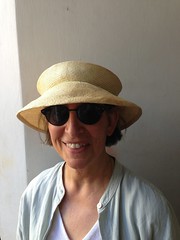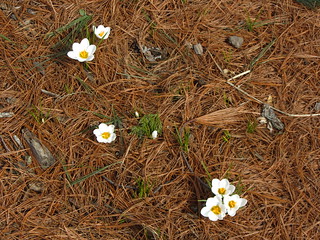
I'm a writer, publishing both as SJ Rozan and, with Carlos Dews, as Sam Cabot. (I'm Sam, he's Cabot.) Here you can find links to my almost-daily blog posts, including the Saturday haiku I've been doing for years. BUT the blog itself has moved to my website. If you go on over there you can subscribe and you'll never miss a post. (Miss a post! A scary thought!) Also, I'll be teaching a writing workshop in Italy this summer -- come join us!
Read/Post Comments (1)

Lost in Newark
I'm taking a class in Asian Art. Yesterday we met at the Newark Museum to see their Tibetan collection, one of the world's best. There are any number of ways to get to the Newark Museum from downtown NYC; typically, I chose the one that involved the most walking. I like to see places. Besides, it was a beautiful day -- FINALLY, spring. So I took the PATH to Newark Penn Station. The Museum's a little over a mile from there, and here's the route: left out of the station to Market, right on Market, right on Washington. Unless you're me. I forget map directions and street names the minute I hear or read them. As I say, I like to see places. I get so involved in looking at what I'm seeing that I don't really look at where I am or remember what I'm supposed to do at any given intersection. I made each one of those turns wrong; it took me 45 minutes to get to the museum.
However, I saw some terrific late 19th - early 20th C. architecture. Newark rose and fell in more or less the same period as Buffalo, where I spent 4 years. I felt right at home with the terra cotta, brick, and cast iron, and also with the sneaker and cheap electronics stores these places have become. Except for the wigs. Downtown Newark seems to be very big on wig stores. Inexplicable, but there you are.
And speaking of being lost, you could get lost for days in the Tibetan collection at the museum. As our teacher pointed out, this is one of the few museums to not only display religious art, but also display it in context, setting up exhibits as temple interiors (with a shrine consecrated by the Dalai Lama, incidentally) so the visitor gets a sense of how the textiles, statues, etc. are used. They also have an exhibit on daily life in Tibet. Any of you within striking distance of this museum and interested in Asian art -- they also have Japanese, Chinese and Korean collections, and early American exhibits also -- I'd recommend it.
However, I saw some terrific late 19th - early 20th C. architecture. Newark rose and fell in more or less the same period as Buffalo, where I spent 4 years. I felt right at home with the terra cotta, brick, and cast iron, and also with the sneaker and cheap electronics stores these places have become. Except for the wigs. Downtown Newark seems to be very big on wig stores. Inexplicable, but there you are.
And speaking of being lost, you could get lost for days in the Tibetan collection at the museum. As our teacher pointed out, this is one of the few museums to not only display religious art, but also display it in context, setting up exhibits as temple interiors (with a shrine consecrated by the Dalai Lama, incidentally) so the visitor gets a sense of how the textiles, statues, etc. are used. They also have an exhibit on daily life in Tibet. Any of you within striking distance of this museum and interested in Asian art -- they also have Japanese, Chinese and Korean collections, and early American exhibits also -- I'd recommend it.
Read/Post Comments (1)
Previous Entry :: Next Entry
Back to Top